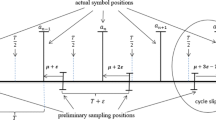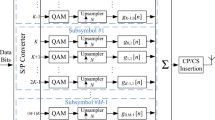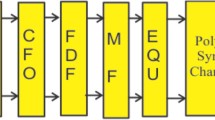Abstract
High performance and reasonable complexity have made pilot-symbol-assisted modulation (PSAM) of great practical interest in mobile communications. However, no previous work has investigated PSAM in burst-mode operation which is commonly encountered in multiple-access schemes (time-division or slow-frequency-hopped system). This paper examines the burst structure design problem in a frequency-flat fading environment. The explicit relationship between error performance and the design parameters, including pilot allocation, frequency offset, Doppler spread, and modulation scheme, is explored. Periodic pilot insertion commonly used for continuous transmission produces degraded performance in burst-mode operation. A new, unequal-pilot-spacing burst architecture is proposed in this paper to achieve better error performance. This work also focuses on the potential performance improvement of a frequency offset estimator and a Doppler spread estimator. The results show that an improvement up to 2.5 dB in SNR/bit can be attained by a Doppler spread estimator. A significant frequency offset can produce an irreducible error floor or a severe reduction in the throughput rate if no compensation is implemented. The performance degradation investigated in this paper can be used to determine the specification of the frequency offset estimator and the Doppler spread estimator used in conjunction with PSAM.
Similar content being viewed by others
References
A. Aghamohammadi and H. Meyr, A new method for phase synchronization and automatic gain control for linearly modulated signals on frequency flat fading channels,IEEE Transactions Communications, Vol. COM-38, pp. 25–29, 1991.
J. K. Cavers, An analysis of pilot symbol assisted modulation for Rayleigh faded channels,IEEE Transactions on Vehicular Technology, Vol. VT-40, pp. 686–693, 1991.
M. L. Moher and J. H. Lodge, TCMP—a modulation and coding scheme for Rician fading channels,IEEE Journal of Selected Areas in Communication, Vol. SAC-7, pp. 1347–1355, 1989.
J. K. Cavers, Performance of tone calibration with frequency offset and imperfect pilot filter,IEEE Transactions on Vehicular Technology, Vol. VT-40, pp. 426–434, 1991.
M. P. Fitz, A dual-tone reference digital demodulator for mobile digital communications,IEEE Transactions on Vehicular Technology, Vol. VT-42, pp. 156–165, 1993.
F. Davarian, Mobile digital communication via tone calibration,IEEE Transactions on Vehicular Technology, Vol. VT-36, pp. 55–62, 1987.
W. C. Y. Lee,Mobile Communications Engineering, McGraw-Hill, New York, 1982.
H. L. Van Trees,Detection, Estimation, and Modulation Theory, Wiley, New York, 1968.
S. Stein, Unified analysis of certain coherent and noncoherent binary communication systems,IEEE Transactions on Information Theory, Vol. IT-10, pp. 43–51, 1964.
J. G. Proakis,Digital Communications, McGraw-Hill, New York, 1989.
J. K. Cavers and J. Varaldi, Cochannel interference and pilot symbol assisted modulation,IEEE Transactions on Vehicular Technology, Vol. VT-42, pp. 407–413, 1993.
J. K. Cavers and P. Ho, Analysis of the error performance of trellis-coded modulation in Rayleigh fading channels,IEEE Transactions on Communication, Vol. COM-40, pp. 74–83, 1992.
M. P. Fitz and J. P. Seymour, On the bit error probability of QAM modulation,International Journal of Wireless Information Networks, Vol. 1, pp. 131–140, 1994.
W-Y. Kuo and M. P. Fitz, Frequency offset compensation and burst design in frequency flat fading channel, Technical Report 94-19, Purdue University, 1994.
Author information
Authors and Affiliations
Rights and permissions
About this article
Cite this article
Kuo, Wy., Fitz, M.P. Designs for pilot-symbol-assisted burst-mode communications with fading and frequency uncertainty. Int J Wireless Inf Networks 1, 239–252 (1994). https://doi.org/10.1007/BF02106591
Issue Date:
DOI: https://doi.org/10.1007/BF02106591




